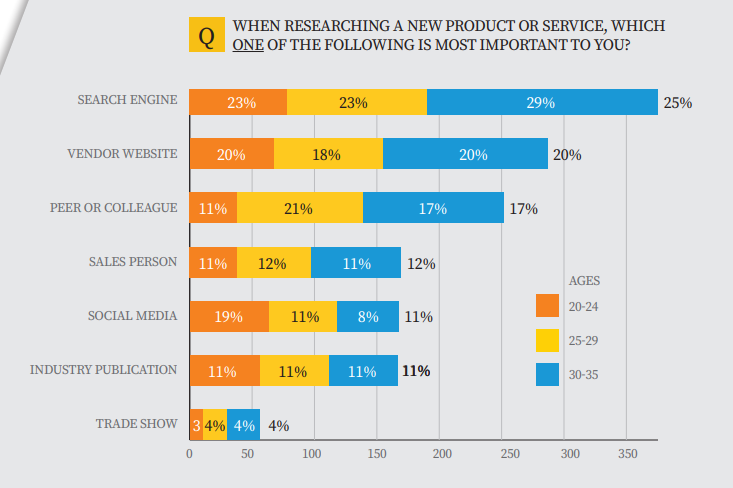How do you know when it is time for a refresh of your visual brand identity? Some leading B2C brands introduce an updated look every few years. Should B2B have the same frequency, or is this unique audience more interested in continuity, consistency and reliability?
The visual identity of a brand is a critical component of helping to grow and maintain brand awareness, engage current and potential buyers, and create a memorable impact with your target audience. It is literally the first thing they see, and as they say, first impressions last. So do you really want to change it? Yes, you do.
Like B2C, buyers want to view your brand or company as relevant, innovative and continuously improving. Maintaining a freshness to your visual brand image can help promote this impression. A refresh can be a major overhaul, or just a template update as part of regular brand maintenance.
As the B2B buyer continues to evolve in how they discover, interact and evaluate suppliers, it is essential to understand this new target audience and stay current with their expectations. Today’s B2B buyers are also digital natives, thus more visual than prior generations, placing an even greater importance on that visual impression.
The New B2B Buyer
Your buyer shops for suppliers the same way they shop for consumer brands—online. And they have the same expectations for visual impact with both experiences. Long gone are the days of B2B brands having a basic block logo, low-end graphics, and an overall utilitarian look. B2B brands are now expected to be more digitally savvy and have a visual sophistication that is on par with B2C brands.
Today’s B2B buyers are discovering and researching suppliers online, with social media and digital content becoming a more critical role in the sales process. One often-cited report states that “57% of the purchase decision is already complete before the customer even calls the supplier.” However, many speculate it is probably much higher, and continuing to grow.
Along with the changes to how buyers get information, the new B2B buying community is younger than ever, and they work differently than their predecessors. 73% of Millennial workers report they are involved in decisions to purchase products or services for their companies, according to a Merit report. These younger B2B buyers are digital natives, having come of age in a more visual generation. Their primary methods of learning about a new product or service is online via search engines and company websites.

Another previous myth of B2B buyer decision-making was the role of emotions. B2C has been thought of as a more impulse-driven and emotional purchase, whereas B2B was perceived to be intellectual, well researched, and more carefully evaluated due to multiple decision-makers often involved and the higher stakes for purchases in general. While this is all true, ultimately, humans are the ones making the decisions, not companies, and emotions do play a role.
Research shows that buyers are looking for three essential feelings when considering suppliers: confidence, optimism, and the potential to trust. All of which you can communicate in the brand’s visual representations that the buyer first sees—often online. First impressions still matter and do stick with a buyer.
We’re seeing a convergence of tactics between B2C and B2B branding and communications.”
David Mack,
Co-Founder, SketchDeck
In today’s digital age with younger Millennial B2B buyers, who first learn about a product or company online, it is vital that you are continuously evaluating your brand’s visual identity. You want to be confident that it is always an accurate reflection of the desired personality of your brand and that it makes the right first impression.

Review and Refresh
Industries, buyers, and companies change, so a visual personality is not forever; it can and should evolve. If you have had the same visual brand identity for three or more years, then now is a good time for a refresh of some degree.
Brand refreshes can be big or small. They can be a slight tweak to keep your look and materials up-to-date, or they can be a larger project to refine a look that is no longer on par with what the brand or organization represents today. When considering a refresh, first analyze if you need to update for strategic marketing reasons or visual design reasons.
The Strategic Refresh
To determine if you need to undertake a strategic refresh to your visual identity, some key areas to evaluate are:
- Has your buyer target changed? Look to your buyer personas and confirm they are still relevant and that your visuals still are a match for your target audience.
- Has your competition shifted? Often an industry can start to merge into one master look. Update your competitive matrix to include logos and visual identities so you can see at a glance how you fit in the industry and if there is one consensus look that you want to break away from.
- Has your company or brand itself changed, evolved, or is focusing on a different feature, benefit, product area or service? If so, maybe it is time for an updated visual to create a better reflection of the new direction or approach.
A complete strategic brand refresh can cover everything from changing or altering a logo to creating a new color palette, fonts used, illustration or photo styles. It might be a slight adjustment to the current brand visual identity or the creation of an entirely new visual system.
Conducting an evaluation of your brand’s visual identity and potential refresh needs is a good practice to build into your long-term planning or 3-year cycle budgets. Due to the time and investment that can be required for a full brand refresh, you will want to plan well in advance.
Template Refresh
If your evaluation has concluded that your brand’s visual identity is still a fit with your marketing strategy, then you might want to consider a template refresh. A template is a visual example and guide for making a large number of materials (e.g. presentations, case-studies) all with the same look and feel. By refreshing a template you can bring some new design ideas to your day-to-day marketing production. There are many reasons to refresh your templates: your brand may have evolved and it’s time to reflect that in your templates; you might want some visual novelty; you can incorporate some newer trends into your templates; or the information you’re designing may have changed format and needs a different template. Updating your templates is a regular and normal part of tending to your brand.
Executing a refresh
Whether you’re embarking on a major brand refresh, or just updating a few templates, there are a number of questions to ask to help guide the effort. First of all, what is in scope for change? Once you begin the process, it can be very tempting for the design team to change more and more things as they spring-clean. By first choosing a scope and aligning everyone around it, you can prevent a lot of budget and deadline creep.
Secondly, who are the design leaders and stakeholders for the changes? Ultimately, someone must decide which ideas are best and guide the effort to efficiently make progress. At the same time, it’s important that the people most affected by the changes (e.g. designers, marketers) can give feedback to what will work for them in their day-to-day production.
Finally, how can you measure success? In the highly subjective world of design, there’s no simple metric like in other areas of business, but nonetheless it’s vital to have an agreed idea of what success looks like. You might want to define some high level goals (“Make the brand feel warmer and more approachable”) and some practical goals (“Make our logo work on any background color”). You can also define the group who will approve the final work.
For a brand refresh, the final deliverable is usually a new or updated brand book. For a template refresh, the template(s) themselves are the deliverable.
We find that brand refreshes typically grow into larger projects than initially forecast; as the brand opens itself up to change, many opportunities for design improvements can be seen. Even with a strictly defined scope, we encourage all clients to allow a generous timeline and extra buffer time to allow full exploration of the ideas and opportunities that come from the project.
Summary
The B2B buyer’s evolution from trade media to social media, relationship sales to online sales, and the younger age groups’ expectations for visuals that can co-exist alongside digital B2C images are all driving the need to approach B2B brand visual in a new way.
B2B visual brand identities must be a current, accurate reflection of your brand’s personality and continually be delivering on those top three emotions that resonate with buyers when selecting new suppliers: confidence, optimism, and the potential to trust.
Continuously re-evaluating and refreshing your visual brand is essential to staying relevant and making an impact in today’s digital marketplace and today’s B2B buyer.
Whether it is a regular template refresh or a larger strategic branding shift, you need to make the refinement of your visual brand identity a constant discipline in your annual planning process. This ongoing refresh expectation will better enable your company to keep pace with the evolving B2B consumer.